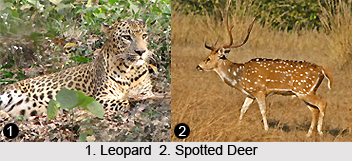Peechi Vazhani Wildlife Sanctuary is one of the popular sanctuaries of Kerala. The sanctuary is located about 20 kms east of Thrissur. Established in the year 1958, the sanctuary has it`s headquarter is in Peechi. It is located 76degree 18` and 76degree 28` East Longitude and 10degree 28` and 10degree 38` North Latitude. Peechi Vazhani Wildlife Sanctuary is the second oldest wildlife sanctuary of Kerala. The sanctuary lies in the catchments areas of Peechi and Vazhani dams in Thrissur District. The sanctuary houses a variety of species of birds as well as wild animals. Peechi Vazhani Wildlife Sanctuary consists of Palappilli and Nelliyampathi forests. The sanctuary comes under the administrative jurisdiction of Peechi Wild life Division of Northern Wild life Circle, Palakkad.
The forests of this sanctuary remained under the ownership of the feudal chief called the Naduvachira till the dawn of the 19th century. The chief paid his humble adherence to the Raja of Cochin.
Geography of Peechi Vazhani Wildlife Sanctuary
 Peechi Vazhani Wildlife Sanctuary experiences heavy rains during the monsoons in the months of June to August. The climate is pleasing here. This enchanting place consists of beautiful plains and scenic hills. The Ponmudi Peak measuring 923 m is the highest point of this region. It extends to the altitude ranging from 45 meters to 900 meters. Peechi Vazhani Wildlife Sanctuary is a perfect place for trekking or even for taking a nature walk. Nature camps are also conducted in the sanctuary on a regular basis.
Peechi Vazhani Wildlife Sanctuary experiences heavy rains during the monsoons in the months of June to August. The climate is pleasing here. This enchanting place consists of beautiful plains and scenic hills. The Ponmudi Peak measuring 923 m is the highest point of this region. It extends to the altitude ranging from 45 meters to 900 meters. Peechi Vazhani Wildlife Sanctuary is a perfect place for trekking or even for taking a nature walk. Nature camps are also conducted in the sanctuary on a regular basis.
Flora and Fauna of Peechi Vazhani Wildlife Sanctuary
Peechi Vazhani Wildlife Sanctuary has a wide range of floral and faunal variety. Floral variety includes Moist Deciduous Forest, Evergreen forests and Semi-evergreen forests. Deciduous forests and semi evergreen forests are confined to higher reach while tropical evergreen forests cover most parts of this sanctuary. Apart from these there are many trees like rosewood, teak, thenmavu, irul and venteak that grow in the sanctuary. karakil, kalpine, whiteakil, kambakam and ambani can also be seen here, are seen. According to research 39 species of mammals, 176 of birds, 30 of reptiles, 17 of amphibians, and 40 of fish are said to be found here. The sanctuary has many rare medicinal plants and herbs.
Peechi Vazhani Wildlife Sanctuary also provides shelter to many animals like tiger, leopard and fox, and herbivores like barking deer, elk, deer, spotted deer, elephant, vixens, wild dogs, and bison. The sanctuary also has a plethora of resident and migratory birds. There are almost 60 types of birds and 10 types of reptiles here.











